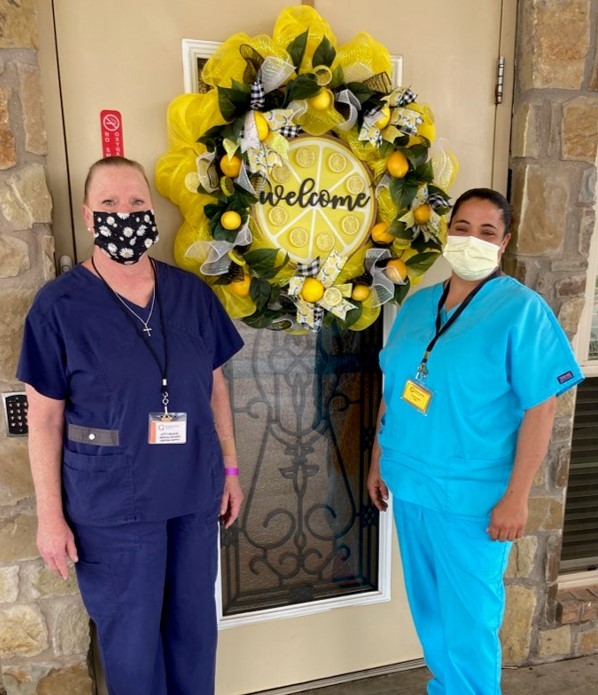 Brightpointe staff Kitty Mladan (left) and Deann Mathis (right)
Brightpointe staff Kitty Mladan (left) and Deann Mathis (right)It is no secret that high staff turnover in nursing homes is a widespread crisis and research shows that it “likely contributed to the shocking number of deaths at facilities during the pandemic,” according to The New York Times (Aug. 21, 2021). "CMS has long identified staffing as a vital component of a nursing home's ability to provide quality care," said Chiquita Brooks-LaSure, administrator for the Centers for Medicare & Medicaid Services (CMS), in a January 2022 news release. In the course of its education and technical assistance outreach, TMF Health Quality Institute found one facility that is successfully addressing this challenge. With some simple yet creative planning and teamwork, Brightpointe at Lytle Lake in Abilene, Texas, has reduced its nursing aide turnover rate from 90% to 21% in two months.
Brightpointe is a skilled nursing facility in the south western portion of Abilene, approximately 180 miles west of Dallas, near the geographic center of Texas. The city’s population is about 125,000. With approximately 85-100 residents, Brightpointe employs a full staff of 109. In January and February 2022, Director of Nursing Reann McGlothlin, BSN, RN, struggled with hiring 20 nursing aides, and losing 18 of them. Her staff was severely challenged.
“Every week we had to report in the National Healthcare Safety Network (NHSN) who is vaccinated and who is not, and there were so many names that we did not recognize. People were leaving so quickly,” McGlothlin said. The first step was to identify who was still working, and then implement something quickly that would improve the retention of new employees. McGlothlin held a leadership meeting with Brightpointe’s Administrator John Lane and Assistant Director of Nursing Mercedes Akins, and together they came up with a plan.
They began with color-coded nametags for staff; new employees wear bright yellow, while other staff wear white tags. “This is a way for new staff to alert others that they may not have all the answers, and encourages others to offer support if someone looks lost or unsure,” said McGlothlin. They discovered that the new name tags helped foster introductions and onboarding of new staff, improving interpersonal relations internally.
Then they devised an intense orientation schedule for new hires. On Wednesdays, they are provided a company benefits overview and lunch with department heads. Thursdays they break out to shadow in their respective departments. For instance, if they are nursing, they team up with a nursing team lead with strong skills; housekeeping and kitchen go to their departments. On Fridays McGlothlin and Akins perform check-offs, verifying that the new staff have the skills and knowledge to care for residents.
The leadership team also appointed a department head mentor and a floor staff mentor, who are available to assist new employees. “As long as they’re employed, they can always seek out guidance from a mentor,” McGlothlin said. “For the mentors, it is an investment in the staff and the organization.”
Since Brightpointe began this new program in March 2022, it has hired 28 aides and lost only six in two months. The retention rate is helping them achieve their staffing goal.
“It is very evident they made a serious investment in their onboarding process and it is paying off,” said TMF’s Quality Improvement Specialist Christy Herber. “Reann also attends our webinars very often and takes new information from them.”
McGlothlin recommends starting new employees during the week; do not start on weekends. “Our staff begin their weekend rotation after they complete their full orientation and check-offs, and have been on the floor one week,” she said.
Brightpointe didn’t stop there. All of the staff got involved and discussed their weekly numbers. As a result, they formed new committees for infection control, falls, behaviors, and urinary tract infection/dehydration. Nurse managers run the committee meetings, but everyone is assigned to these committees and new staff are encouraged to join a committee right away; they should be on a committee within 30 days.
What other positive outcomes did Brightpointe realize from these interventions? “Connections to new staff. Getting to know them as a person,” McGlothlin said. “We spend a lot of time with our work family. They need to be comfortable to speak to us.”
Lastly, McGlothlin encourages other providers to learn from Brightpointe’s success. “Getting out of the 'cycle' of being staff-challenged is hard and takes everyone. In the end, it is so worth it!”